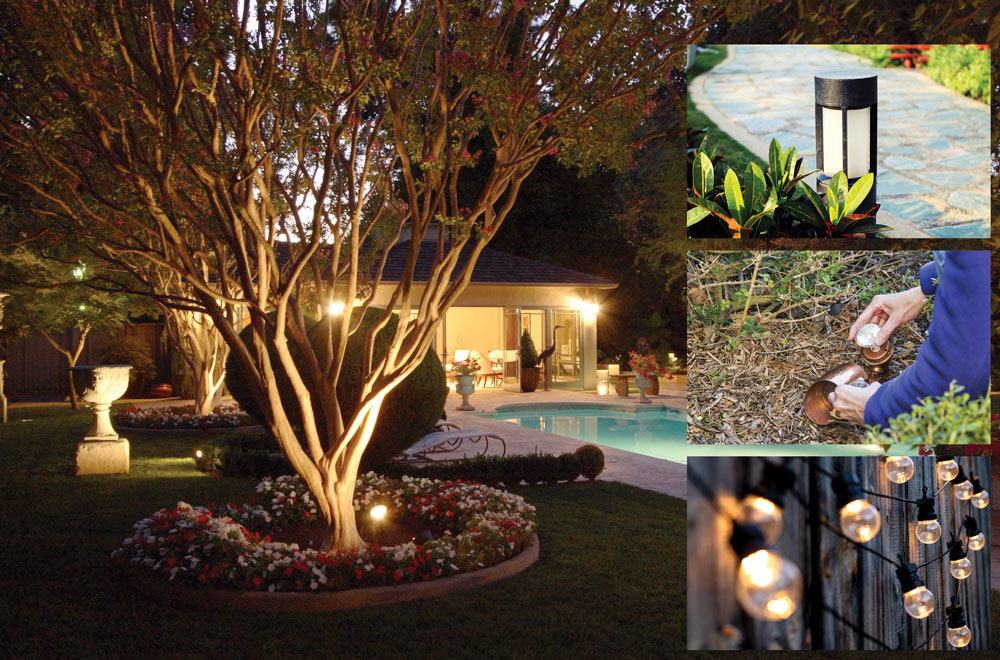
On the patio, around the pool, enjoying a barbecue or just watching the kids play, Texas days are extended further into the evening with the addition of any of the many outdoor lighting options. There are a lot of choices to consider, from 120-volt, hardwired flood lights, to low voltage wired systems and finally, solar powered lights.
For years, we have used wired flood lights, mounted to the corner eaves of our homes to provide light just for walking through our yards, and also for security. A well-illuminated yard may deter would-be burglars, as well as discourage destructive nocturnal pests. These lights are generally 120-volt systems and may include both sensors to only come on after natural light fades and motion sensors. On some models, the motion sensor will turn the light on from complete darkness, but often today, the lights will have a low-power mode, and the lights will come on to their fullness when a motion sensor is activated. These lights may also be set with timers. While 120-volt systems have been the norm for many years, the advent of LED lights and small solar panels may be a more cost-effective option. Small solar panels may be attached to the light with a small wire, enabling the light to be under the eave and the solar panel on the roof.
Path lighting is an option for a safe way to navigate around the yard with a minimal amount of soft to moderately bright safety and landscape light. The low-voltage systems require a wired installation with a transformer to change your 120-volt house current to a 12- to 15-volt system. About the only drawback to this system is the wiring. Wiring needs to be buried between the lights — and, of course, consideration has to be given to avoid damaging the wires when working flower beds or doing other yard work. The solar option comes into play again with path lights. The investment into quality solar-powered path lights has become very economically attractive, and the lights are available for purchase either individually or in sets. Typical installation may only require driving a metal or plastic stake into the ground and attaching the light to the stake. The solar panels are built into the top of the individual lights and power rechargeable batteries. While there are some path lights that include motion sensors, most only include the optical sensor that turns them on at dusk and off at dawn.
A popular option for patio lighting is string lights. These are typically low-voltage lights that emit a warm color that will add to the ambience of outdoor meals around the grill or firepit. The lights may be strung just about anywhere and may hang permanently from the eaves of the home around the patio, or loosely over the tables and chairs from the corner posts of an outdoor pavilion or gazebo. Again, if you are not interested in a permanently wired system, the portable, solar-powered option appeals to many and allows the string lights to be placed in different areas as your outdoor events may require. These lights are often seen illuminating personal campsites for both RV and tent campers.
Deck lights are small, often recessed lights that are installed around the perimeter of the deck surface, as well as between the individual steps of stairs and along the side railing. Deck lights provide safety against trip and fall hazards, as well as providing accent light for garden plants that surround the deck. A low-voltage system is usually a good option, and the lights are typically wired together rather than operating from a single powered source, whether it be solar or a transformer from the 120-volt system.
While all of the lights discussed up to this point have been of the flood-light variety, spotlights may also play an important role in outdoor lighting for accenting pool and garden areas. These lights are also known as “up-lighting” and shine narrower beams to highlight plants, statuary, garden ornaments and water features. These lights may typically be chosen and installed when a major landscape project is being constructed, such as a pool or new patio. However, LED lights that stand alone and may be solar powered are becoming more popular and are economical, widely available and easy for the do-it-yourself homeowner.
Sources:
1. www.bobvila.com.
2. www.familyhandyman.com.
Written by Bill Smith

You must be logged in to post a comment.